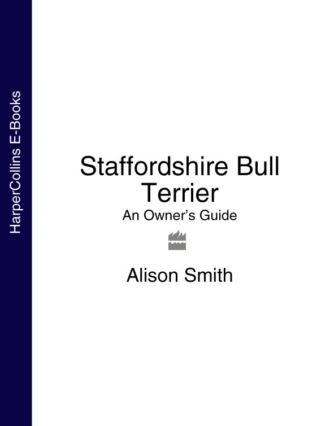
Полная версия
Staffordshire Bull Terrier: An Owner’s Guide

STAFFORDSHIRE BULL
TERRIER
AN OWNER’S GUIDE
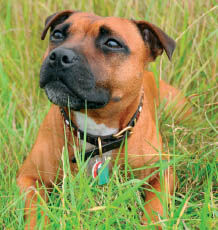
Alison Smith
Healthcare by David Taylor

Dedication
To the most special people in my life, without whom I would not be what I am now: John Fletcher, Ruth and Willis Ford, my husband Syd, my babies Zara and Asher, Jayne Pashley and Dan-Dan! Also Arlene Fletcher, my Mum, who I miss beyond words.
Contents
Cover
Title Page
Dedication
Part 1 You and your dog
Chapter 1 History of the breed
Chapter 2 Acquiring a puppy
Chapter 3 Socialization and training
Chapter 4 Your adult dog
Chapter 5 Behaviour
Chapter 6 Showing and fun
Part 2 Healthcare
Keep Reading
Useful information
Index
Acknowledgements
About the Authors
Copyright
About the Publisher
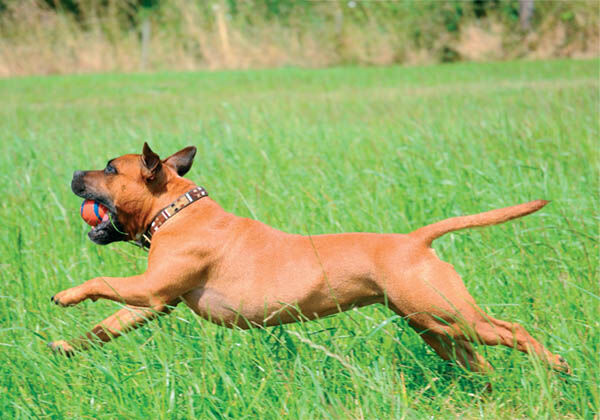
PART ONE
YOU AND YOUR DOG
Owning a dog is a huge responsibility but extremely rewarding. When you decide to welcome a Staffordshire Bull Terrier into your home, you have to consider not only how he will fit into your lifestyle but also what you can offer him in return. He will need regular exercise, feeding, games and companionship as well as daily care.
Chapter 1
History of the breed
The history of the dog known today as the Staffordshire Bull Terrier is, perhaps, one of the most well known histories of any breed. This loyal, people-loving dog still carries with him all the best traits that have been bred into him over the centuries to make him one of the most wonderful family pets imaginable.
Bloodsports
In the early nineteenth century, terriers of all kinds were bred for their ability to take part in what were then known as bloodsports, the two most popular being bull-baiting and cock-fighting. In the mid-1800s, bulls were brought to markets and upon by dogs. Baiting was done for two reasons: to tenderize the bull’s meat and provide entertainment for the spectators, who enjoyed nothing more than watching the specially bred dogs bring down a bull. This pastime also extended to bears and other animals.
These bloodsports were very common at this time and would often take place in villages and at country fairs. The dogs would grab the bulls and be tossed around, sometimes even being hurled over a bull’s head, only to be thrown back into the action by their owners.
Bred to win
The secret to a winning dog’s success lay in the strength of his jaw. The ability to ‘lock’ his jaws onto another animal meant that, no matter how strong the opposition, the steely grip and weight of the dog would eventually tire the bull out and bring it down.
Another trait of the Staffordshire Bull Terrier was (and still is) its incredible tolerance to pain. This meant that they invariably continued to hang on, despite suffering severe injuries.
These early dogs bore no resemblance to the noble breed we are used to today. They were bred not for their pleasing looks but for what was then known as their ‘gameness’ – in other words, their strength and skill against animals which were over 20 times their size.
The Stafford’s fearless nature, together with his in-built resolve never to quit, are still much in evidence in the breed today, although modern breeders are also careful to breed for a good, sound temperament in their dogs, so that they will make good family pets.
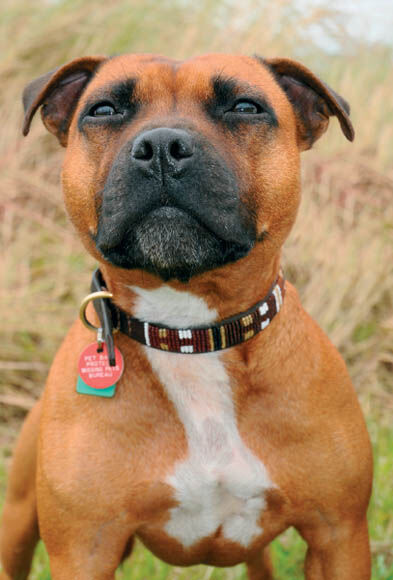
The loyal Staffordshire Bull Terrier is one of the most noble looking and wonderful dogs imaginable
Origins of the breed
The modern breed owes much of its physical attributes to the Bulldog. However, the Bulldog of the nineteenth century was a somewhat larger dog than the big-jawed and handsome one of today, with longer legs and a much more refined head, more reminiscent of the American Staffordshire Bull Terrier. The Bulldog is believed to have been crossed with several other terrier breeds in a bid to attain a dog which combined great physical strength in the head and body with an agile swiftness. This was an ideal combination for a dog who was expected to fight in small areas, often known as ‘pits’. These breeds were often referred to as ‘Half-and-Halfs’, in a nod to the two distinct breeds that had produced them. The breed nowadays resembles both the Bulldog and the terrier, with evidence of the former still clearly seen in the head.
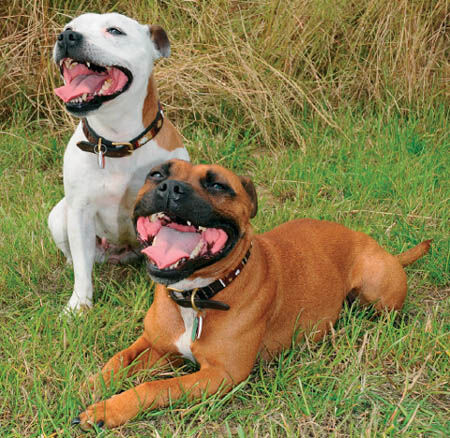
The breed nowadays still shows clear signs of its Bulldog and terrier ancestry. Note the famous Stafford smile, as shown above by these two handsome dogs!
The word Staffordshire relates to the part of the United Kingdom where the breed first became popular in the mid 1800s, particularly among the working classes. The Staffordshire area of the Midlands, including Birmingham, Walsall and Stoke-on-Trent, saw extensive breeding of both of this dog’s forebears – Bulldogs and terriers.
The motivation was still to achieve the perfect fighting dog, and even though dog fighting was outlawed in the early 1900s, many fanciers continued to breed with the fight in mind and dogs still went head to head with each other. These clandestine fights were organized by word of mouth, culminating in a ‘game’ played out in someone’s home, backyard or a disused building. Thus the name of the breed is a tribute both to its forefathers and place of origin, making it truly British.
Interestingly, whilst this breed’s aggression towards other dogs was never doubted, it is a fact that people were often to be seen handling the dogs in the fighting pits, and yet they were rarely attacked. This is a testament to the breed’s love of humans, and it is this quality that makes the Stafford such a wonderful companion to this day.
The early days
In 1888, the Bull Terrier Club of England was formed and subsequently the members published a Breed Standard – a blueprint for the breed. This Standard listed all the desirable physical and temperament points that any breeder should aspire to. All recognized breeds nowadays have their own Breed Standards, which are laid down by the Kennel Club and should be closely adhered to by breeders.
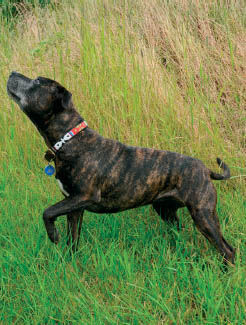
This Stafford combines the physical strength and agility which his forebears were bred for. Staffords are always happy to display their keenness for life.
The Staffordshire Bull Terrier had to wait until the 1930s before fanciers decided to try and establish it as a breed in its own right, rather than the loose blend of bull and terrier which had existed until that time. This was due partly to the fact that the abolition of dog fighting was now being strictly enforced and ‘underground fights’ were regularly stopped by the police and the organizers were punished. Illegal fighting continued, however – and, sadly, still does – albeit to a much lesser degree.
Having lost their ‘sport’ to these new laws, breed enthusiasts started to think about what else they could do to show off their stock to other like-minded people. One way was to follow in the footsteps of many other dog breeds and perhaps start to compete against each other, not in the pit this time but in the show ring at a dog show.
The first Standard
At this point, the Stafford, as we know it now, was clearly recognizable. By cleverly breeding like to like, a very distinct and unique-looking dog was emerging. The very first Breed Standard was written by two of the Stafford’s most famous custodians and breeders, Joe Dunn and Joe Mallan. The writings were based on a dog called Jim the Dandy, which was owned by Jack Barnard. Early pictures of the breed show a dog that was taller and perhaps finer looking than the Stafford today, and possibly closer to its cousin, the Bull Terrier.
In 1935, this prototype Standard was accepted at the first meeting of the newly formed Original Staffordshire Bull Terrier Club. In June of the same year, the Kennel Club (the UK’s official canine governing body) officially accepted it, too, thereby opening up a whole new world for the enthusiasts of the breed – the dog show.
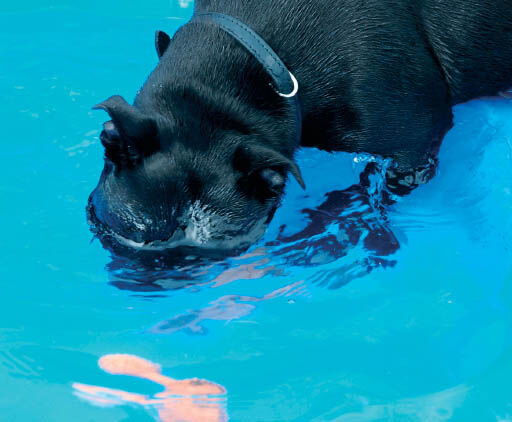
Popular the world over, the Staffordshire Bull Terrier is a happy-go-lucky companion who will be eager to try everything. Some even love water and swimming.
It is perhaps unfortunate that many lovers of the breed in the mid-1930s, including people who had bred for years to create the Stafford, felt that the sport of showing was less than ideal. For them, a dog bred primarily for fighting would lose some of this trait if he was bred instead for the show ring, where a lack of ‘action’ would leave him naturally less aggressive over a period of time. Indeed, many secret fights were still going on, and some dogs continued to be bred for their prowess in a fight rather than in competition against the Standard.
A year later, in 1936, the Original Staffordshire Bull Terrier Club became known as the Staffordshire Bull Terrier Club, following some complaints from the Bull Terrier Club concerning the word ‘original’.
First shows and famous winners
It is widely believed that the very first appearance of the breed as an exhibit was in June 1935 at Hertfordshire Agricultural Show. The first Staffordshire Bull Terrier Club show was held two months later in August at Cradley Heath in the West Midlands. The records show that 60 dogs and bitches were entered.
Around this time the breed was expanding rapidly in numbers and was sought after both as a pet and as a show dog. Whilst its origins were still very much to the fore, its popularity in the show ring meant that it was seen by many more people, as quite often the dog shows were held in conjunction with local agricultural shows, which attracted hundreds of visitors.
Challenge Certificates (see page 88) were granted to the breed by the Kennel Club not long afterwards, and the first Stafford to be awarded this high honour was a beautiful dog called Gentleman Jim at the Birmingham National championship show, which is still held in the UK every year.
In 1936, the breed was given its own class at Crufts Dog Show, and this was won by Cross Gunns Johnson, owned by Joe Dunn. In June 1946, the Southern Counties Staffordshire Bull Terrier Club held the first championship show purely for the Stafford, and breed fanciers saw an incredible entry of 300 dogs, which was testimony again to the growth in the breed’s popularity.
Other dogs worthy of note at this time were Champion Gentleman Bruce, Champion Wardonion Corniche and Champion Brindle Crescendo of Wychbury. Pictures of them show a dog that had by now become much more uniform in appearance, although still perhaps a little taller than it is now.
The breed internationally
Nowadays the breed is very popular the world over. From America to Australia, from Russia to Argentina, the Stafford is revered as a wonderful pet and successful show dog. Sadly, however, there are some countries where the breed is the target of what is known as Breed Specific Legislation (BSL). This legislation came about because of a general confusion over the Staffordshire Bull Terrier and other breeds, namely the Pit Bull Terrier and several crosses of other breeds with the Stafford. Unfortunately, the physical similarities between these breeds can sometimes appear to be quite close to the uninitiated, although to the trained eye there are many differences.
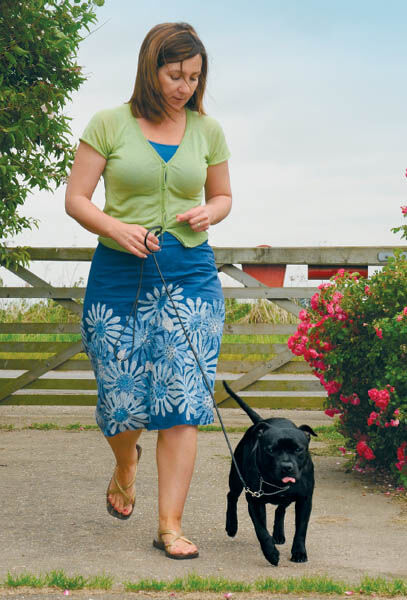
As a responsible owner, you will spend many happy hours with your well trained Stafford, walking him and playing.
The German government tried to ban the breed across the European Union in September 2000, but luckily the intervention of the UK Kennel Club stopped this happening. The breed was banned in Ontario, Canada, in August 2005, and several other countries are closely watching the breed known as the Pit Bull Terrier. Therefore it is important that all Stafford owners behave very responsibly to avoid their breed being placed in the same category.
The Dangerous Dogs Act
As a responsible Stafford owner, the 1991 Dangerous Dogs Act (DDA) is extremely unlikely to affect you or your dog. Owning a pedigree Stafford is perfectly acceptable in the UK. However, you must always make sure that your dog’s pedigree and Kennel Club papers are available, as sometimes authorities with little expertise in the breed can confuse them with banned breeds. It is also worth bearing in mind that the Stafford is banned or under severe legal restriction in Germany, Israel and Canada. Legal restrictions can take the form of muzzling your dog in public, having to obtain a special licence, a ban on breeding and/or selling and, possibly, even having to take out special insurance for your dog.
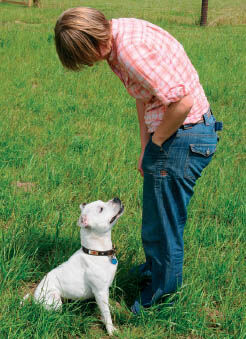
This owner has total control over her Stafford, who is displaying his full attention. Never allow your new dog off the lead until you have full control over him.
The problem that the DDA does pose to Stafford owners in the UK is that a Stafford may physically resemble the Pit Bull Terrier to a person who is unfamiliar with the breed, which may be confusing to the uninitiated. Never allow your dog to run wild in open spaces until you are 100 per cent sure that you have full control over him, and never encourage him to display any aggression towards people or other dogs. For more information on the Dangerous Dogs Act, see page 126.
Breed Standard
General appearance Smooth-coated, well balanced, of great strength for his size. Muscular, active and agile.
Characteristics Traditionally of indomitable courage and tenacity. Highly intelligent and affectionate, especially with children.
Temperament Bold, fearless and totally reliable.
Head and skull Short, deep through with broad skull. Very pronounced cheek muscles, distinct stop, short foreface, nose black.
Eyes Dark preferred but may bear some relation to coat colour. Round, of medium size, and set to look straight ahead. Eye rims dark.
Ears Rose or half pricked, not large or heavy. Full, drop or pricked ears highly undesirable.
Mouth Lips tight and clean. Jaws strong, teeth large, with a perfect, regular and complete scissor bite, i.e. upper teeth closely overlapping lower teeth and set square to the jaws.
Neck Muscular, rather short, clean in outline gradually widening towards shoulders.
Forequarters Legs straight and well boned, set rather wide apart, showing no weakness at the pasterns, from which point feet turn out a little. Shoulders well laid back with no looseness at elbow.
Body Close-coupled, with level topline, wide front, deep brisket, well sprung ribs; muscular and well defined.
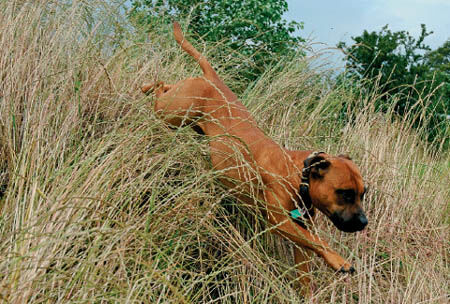
Boldness and courage are two words that are often used to describe the breed.
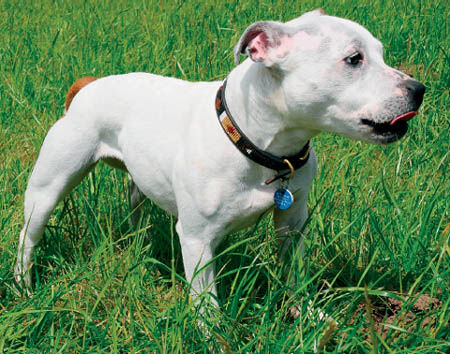
The Stafford is a strong dog with a distinctive head and a very muscular body.
Hindquarters Well muscled, hocks well let down with stifles well bent. Legs parallel when viewed from behind.
Feet Well padded, strong and of medium size. Nails black in solid coloured dogs.
Tail Medium length, low-set, tapering to a point and carried rather low. Should not curl much and may be likened to an old-fashioned pump handle.
Gait/movement Free, powerful and agile with economy of effort. Legs moving parallel when viewed from front or rear. Discernible drive from hindlegs.
Coat Smooth, short and close.
Colour Red, fawn, white, black or blue, or any one of these colours with white. Any shade of brindle or any shade of brindle with white. Black and tan or liver colour highly undesirable.
Size Desirable height at withers 35.5–40.5cm (14–16in), these heights being related to the weights. Weight: dogs: 12.7–17kg (28–38lb); bitches 11–15.4kg (24–34lb).
Faults Any departure from the foregoing points should be considered a fault and the seriousness with which the fault should be regarded should be in exact proportion to its degree.
Note Male animals should have two apparently normal testicles fully descended into the scrotum.
© The Kennel Club
The Staffordshire Bull Terrier
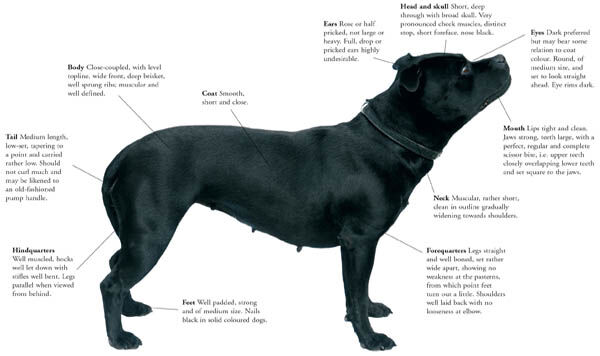
Конец ознакомительного фрагмента.
Текст предоставлен ООО «ЛитРес».
Прочитайте эту книгу целиком, купив полную легальную версию на ЛитРес.
Безопасно оплатить книгу можно банковской картой Visa, MasterCard, Maestro, со счета мобильного телефона, с платежного терминала, в салоне МТС или Связной, через PayPal, WebMoney, Яндекс.Деньги, QIWI Кошелек, бонусными картами или другим удобным Вам способом.


